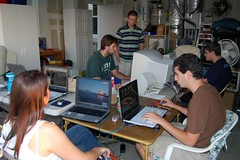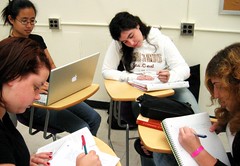Next week, Time Magazine’s cover article, How to Bring Our Schools Out of the 20th Century, will bring to the forefront — for one week — issues that we’ve been talking about (angsting over) for years. There’s not much that’s new here but it is a new and unique opportunity to get some of these ideas out in front of people who still envision their own 1970s (or 1950s) classrooms when they think of education.
That said, I must admit some apprehension. I remember how excited I was, back in 1983, when the Nation at Risk report was published, pointing to an education system built on mediocrity. I thought that finally we would start investing in education. As it turned out, all that got invested was a new platform from which politicians could blame educators and promote their own brand of industrial age education.
Even though the Time story explicitly criticizes the mechanized classrooms of the past (and present), I’m still a bit afraid that the wrong people will be empowered to affect change — rather than empowering educators to reinvent education. I’m not saying that we can do it alone, but no one knows more about teaching and learning than we do.
Now for a few reactions to the story.
…Kids spend much of the day as their great-grandparents once did: sitting in rows, listening to teachers lecture, scribbling notes by hand, reading from textbooks that are out of date by the time they are printed…
It’s grandparents, and parents who were taught by grandparents, who maintain our education system. I suspect that there may be some way to insert the very children we are teaching into the formula, some way that they might come to define certain aspects of their own education. After all, the future we’re preparing them for is the future they will invent.
This is a story about the big public conversation the nation is not having about education, the one that will ultimately determine not merely whether some fraction of our children get “left behind” but also whether an entire generation of kids will fail to make the grade in the global economy because they can’t think their way through abstract problems, work in teams, distinguish good information from bad or speak a language other than English.
 |
| Add this image & link to your blog or classroom web site |
This is what the story is about, and I hope that we can get a lot of people to read it. Perhaps we should all put a picture of the magazine on our blogs and classroom web sites. I wonder if Blogmeister teachers would mind if I put it on all student and teacher blogs. Better ask!
The 21st Century Skills, as described in the article. The report from the New Commission on the Skills of the American Workforce seems not to be available yet.
Today’s economy demands not only a high-level competence in the traditional academic disciplines but also what might be called 21st century skills. Here’s what they are:
- Knowing more about the world
- Thinking outside the box
- Becoming smarter about new sources of information
- Developing good people skills
Certainly there are teachers and administrators who are leading the way in each of these areas. However, world studies, creativity, information literacy, and interactive skills are not part of THE STORY of classrooms that people typically think of and tell. We’ve got to change that story.
Can our public schools, originally designed to educate workers for agrarian life and industrial-age factories, make the necessary shifts? The Skills commission will argue that it’s possible only if we
..add new depth and rigor to our curriculum and standardized exams,
But what does this mean? Who knows what this looks like? Who can speak both from the point of view of the trained and experienced teacher and classroom manager, and from the context of a rapidly-changing, information-driven, technology-rich world? No one I know! More later on this…
..redeploy the dollars we spend on education,
Certainly this is true. However, we can’t do it the way its been done for the past five+ years, taking from one critical program and giving to another critical program. It’s how we got in this mess, by rightly deploying resources to assure that all children could read and do basic math, but away from equally critical programs like social studies, music, art, and innovative education.
I think that one of the most important things we could invest in is the time for our teachers to pay attention, interact, reflect, and reinvent their own classrooms.
..reshape the teaching force and
Again, what does this look like. We can certainly change pre-service. Not easily, but it’s a solid thing that can be retooled. We can also implement ongoing inservice. But a continually adapting teaching force is not something that you just fix. It’s got to be part of the culture of the job. It’s why much more professional time for teachers is so crucial, so that retooling is something that they do everyday as part of being a teacher, not just a servicing you get every couple of months.
..reorganize who runs the schools.
This one’s easy. Trained and experienced educators run the schools. But perhaps more than anything else, education in the 21st century is about conversations, and our schools must operate within conversations between classrooms and homes, schools and communities, and lots of potent, two-way conversations between students and their learning experiences.
Most of the rest of the story includes some inspiring examples of schools that are moving to the edge of the wave. But what they make me wonder is if all schools might become charter schools. Each school is free to reshape itself within the context of a dynamic curriculum that reflects today and tomorrow, but incorporating local needs, local opportunities, and a desperate need to make schools powerful engines for improving neighborhoods, villages, cities and the world.
2¢ Cents Worth
 I am often criticized for serving to much honey with my presentations about technology and the new information landscape — and rightly so. I tend to present almost exclusively the positive and productive side of these tools. I have done a number of parent presentations about the challenges of online digital children, but even those tend to be overwhelmingly positive. I simply ask parents to be parents.
I am often criticized for serving to much honey with my presentations about technology and the new information landscape — and rightly so. I tend to present almost exclusively the positive and productive side of these tools. I have done a number of parent presentations about the challenges of online digital children, but even those tend to be overwhelmingly positive. I simply ask parents to be parents.  That said, I got an e-mail yesterday from Jeff Cannon, a principal in Corpus Christi, Texas. Cannon has created an interesting web site called, Report a Bully. You can register your school for free, make students aware of the site via your school site, policy booklet, etc. — and then ask students to annonymously report those who are hurting or threatening to hurt other students at the school.
That said, I got an e-mail yesterday from Jeff Cannon, a principal in Corpus Christi, Texas. Cannon has created an interesting web site called, Report a Bully. You can register your school for free, make students aware of the site via your school site, policy booklet, etc. — and then ask students to annonymously report those who are hurting or threatening to hurt other students at the school.


 A couple of weeks ago, at my state’s educational technology conference (
A couple of weeks ago, at my state’s educational technology conference (
 We are all so different. But I suspect that the place we are most different is in how we think.
We are all so different. But I suspect that the place we are most different is in how we think. 
 For blogging, I am using
For blogging, I am using 
 Some of the folks at the Class Blogmeister mailing list have been talking about evaluating their students’ blogs. They’re looking for rubrics and other tips for assessing student bloggings. One rubric that came to our attention was a
Some of the folks at the Class Blogmeister mailing list have been talking about evaluating their students’ blogs. They’re looking for rubrics and other tips for assessing student bloggings. One rubric that came to our attention was a